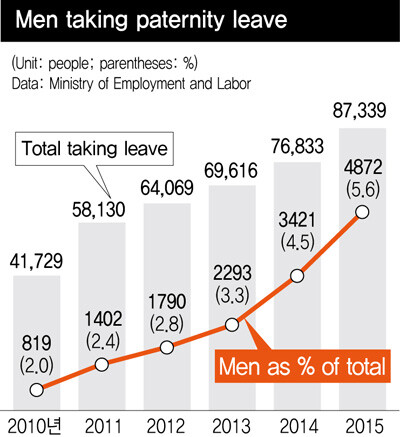hankyoreh
Links to other country sites 다른 나라 사이트 링크
More South Korean men taking paternity leave

More and more South Korean fathers are choosing to take paternity leave.
While they still represent a small minority compared to mothers taking time off from work to raise children, the rate of increase has been sharp in recent years.
The Ministry of Employment and Labor announced on Feb. 3 that a total of 4,872 males had taken paternity leave in 2015, an increase of 42.4% from the year before. The number has been steadily growing, with 819 men taking paternity leave in 2010, 1,790 in 2012, and 3,421 in 2014.
The rise has resulted in men accounting for 5.6% of the 87,339 total people taking childcare leave, marking the first time the rate has been over 5%. That percentage has also been rising notably in recent years, jumping from 2.0% in 2010 to 2.8% in 2012 and 4.5% in 2014.
By region, well over half the paternity leave takers (69.1%) came from the greater Seoul region, which includes the capital along with Incheon and the surrounding Gyeonggi Province. Daejeon, a city that houses numerous public institutions, came in fourth, but the total number of males taking paternity leave remained small, at 201.
The highest rates of increase in paternity leave were found in Gwangju (83.9%) and South Gyeongsang Province (67.6%). By industry, paternity leave was found most commonly among men working in manufacturing; publishing, communications, and information services; and wholesale and retail sales.
Leading the rise in paternity leave are employees at major corporations. Indeed, the percentage of employees taking paternity leave at businesses with fewer than 300 employees actually fell from 47% in 2014 to 44.7% last year. In contrast, workers at businesses of that size accounted for 76.5% of those taking advantage of a system offering men shorter working hours after childbirth to allow them to balance childcare and work duties.
With the system offering shorter hours at proportionally reduced pay, the option appears to be commonly used in place of paternity leave at smaller businesses where absences create more of a burden.
The South Korean government has also moved to increase support for paternity leave to help promote work-life balance. The duration of the “father’s month” system, which provides up to 1.5 million won (US$1,250) in childcare leave pay for the second of two parents to take leave alternately for the same child, was increased from one month last year to three months as of 2016. The administration also submitted plans to the National Assembly late last year for an amendment to the Act on Equal Employment that would increase the usage period for reduced working hours to up to two years.
“We’re planning to step up oversight for smaller businesses and irregular positions where [employees] have been unable to take full advantage of systems like maternity leave and paternity leave,” pledged Na Yeong-don, Director General of the Youth and Women’s Employment Policy Bureau for the Ministry of Employment and Labor.
By Noh Hyun-woong, staff reporter
Please direct questions or comments to [english@hani.co.kr]

Editorial・opinion
![[Column] Season 2 of special prosecutor probe may be coming to Korea soon [Column] Season 2 of special prosecutor probe may be coming to Korea soon](https://flexible.img.hani.co.kr/flexible/normal/500/300/imgdb/original/2024/0426/3317141030699447.jpg) [Column] Season 2 of special prosecutor probe may be coming to Korea soon
[Column] Season 2 of special prosecutor probe may be coming to Korea soon![[Column] Park Geun-hye déjà vu in Yoon Suk-yeol [Column] Park Geun-hye déjà vu in Yoon Suk-yeol](https://flexible.img.hani.co.kr/flexible/normal/500/300/imgdb/original/2024/0424/651713945113788.jpg) [Column] Park Geun-hye déjà vu in Yoon Suk-yeol
[Column] Park Geun-hye déjà vu in Yoon Suk-yeol- [Editorial] New weight of N. Korea’s nuclear threats makes dialogue all the more urgent
- [Guest essay] The real reason Korea’s new right wants to dub Rhee a founding father
- [Column] ‘Choson’: Is it time we start referring to N. Korea in its own terms?
- [Editorial] Japan’s rewriting of history with Korea has gone too far
- [Column] The president’s questionable capacity for dialogue
- [Column] Are chaebol firms just pizza pies for families to divvy up as they please?
- [Column] Has Korea, too, crossed the Rubicon on China?
- [Correspondent’s column] In Japan’s alliance with US, echoes of its past alliances with UK
Most viewed articles
- 1Samsung subcontractor worker commits suicide from work stress
- 2Division commander ordered troops to enter raging flood waters before Marine died, survivor says
- 3‘We must say no’: Seoul defense chief on Korean, USFK involvement in hypothetical Taiwan crisis
- 4No good, very bad game for Korea puts it out of Olympics for first time since 1988
- 5[Column] Season 2 of special prosecutor probe may be coming to Korea soon
- 6[Editorial] Korea’s surprise Q1 growth requires objective assessment, not blind fanfare
- 7Korea’s 1.3% growth in Q1 signals ‘textbook’ return to growth, says government
- 8US overtakes China as Korea’s top export market, prompting trade sanction jitters
- 9[Column] Has Korea, too, crossed the Rubicon on China?
- 1046% of cases of violence against women in Korea perpetrated by intimate partner, study finds